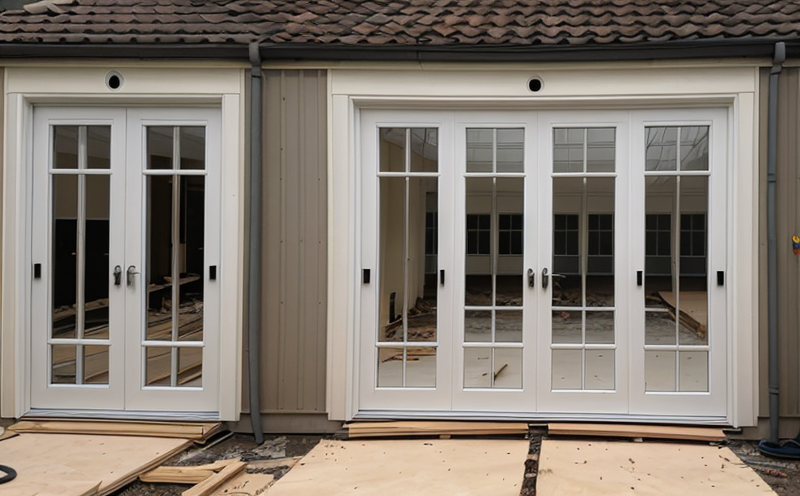EN 1364-1 Fire Resistance Testing of Non-Loadbearing Partitions
The EN 1364-1 standard specifies the procedures for determining the fire resistance of non-loadbearing partitions. These partitions are essential components in building design, providing separation and protection against fire spread within a structure. This service ensures that such partitions meet stringent international standards, safeguarding lives and property.
Fire resistance testing is crucial for ensuring compliance with regulatory requirements and enhancing safety in buildings. Non-loadbearing partitions include walls, ceilings, and floors that do not support the weight of the building above them but play a critical role in fire containment. The test assesses the ability of these partitions to withstand exposure to a standard fire environment without collapsing or compromising the structural integrity.
EN 1364-1 outlines specific conditions under which specimens are exposed to a controlled fire. These tests simulate real-world scenarios that partition materials might encounter in case of a fire. The service involves preparing and installing the specimen according to precise specifications, subjecting it to high temperatures and flames for a set duration, and then evaluating its performance.
Testing parameters include the temperature, duration of exposure, and the type of fire source used. Specimen preparation requires careful attention to detail, including ensuring that any joints or connections are representative of actual construction practices. The instrumentation used in these tests includes thermocouples for measuring temperature gradients and cameras for recording the behavior of the specimen.
At the end of the test, various aspects are evaluated to determine compliance with EN 1364-1. These include structural integrity, thermal insulation performance, and smoke generation. Structural integrity is assessed by checking if any significant deformation or collapse has occurred. Thermal insulation performance measures how effectively the partition can prevent heat transfer from one side to another.
Smoke generation is also an important factor as it indicates the potential for producing toxic gases during a fire. Compliance with EN 1364-1 ensures that the tested partitions meet stringent safety standards, reducing the risk of rapid spread of fire and smoke within buildings. This service provides assurance to clients that their products adhere to international best practices in fire safety.
Our team of experts uses state-of-the-art facilities and equipment to conduct these tests accurately and efficiently. With years of experience, we ensure reliable results every time. Compliance with EN 1364-1 is not only a requirement for manufacturers but also an important step towards maintaining a safe environment in buildings.
Understanding the context within which this testing occurs helps clients appreciate its significance. In fire safety design, partitions serve as barriers to prevent fires from spreading rapidly through a building. They also act as smoke control measures by containing smoke and gases within areas of origin until they can be safely evacuated.
| Parameter | Description |
|---|---|
| Temperature | Controlled fire environment with specified temperatures. |
| Durability | Duration of exposure to the fire source. |
| Type of Fire Source | Ethylene Oxide (EO) or other standard sources as per EN 1364-1. |
| Performance Metrics | Description |
|---|---|
| Structural Integrity | No significant deformation or collapse of the partition. |
| Thermal Insulation Performance | Maintains a certain temperature gradient between sides during fire exposure. |
| Smoke Generation | Minimal smoke production to ensure safe evacuation routes. |
Applied Standards
The EN 1364-1 standard is widely recognized and applied in the fire safety testing of non-loadbearing partitions. This section provides an overview of the key aspects covered by this standard.
| Standard | Description |
|---|---|
| EN 1364-1:2005 | Specification for the determination of fire resistance of non-loadbearing partitions. |
| ISO 9708 | Fire tests on building materials and products - Determination of structural integrity under standard fire conditions. |
| ASTM E119 | Standard test methods for fire resistance of building materials. |
The EN 1364-1:2005 specification is the cornerstone of this testing procedure. It mandates specific conditions under which tests should be conducted, ensuring consistency and reliability across different laboratories. ISO 9708 complements these requirements by focusing on structural integrity during fire exposure, while ASTM E119 provides additional insights into broader fire resistance testing methodologies.
These standards collectively provide a robust framework for evaluating the performance of non-loadbearing partitions under controlled fire conditions. Compliance with EN 1364-1 ensures that tested products meet stringent international safety criteria, enhancing overall building safety and reducing risks associated with fires.
Eurolab Advantages
At Eurolab, we pride ourselves on offering comprehensive fire resistance testing services tailored to the specific needs of our clients. Our expertise in this field allows us to provide unparalleled quality and reliability in our testing processes.
- State-of-the-art facilities equipped with advanced instrumentation.
- Experienced technical staff with extensive knowledge of EN 1364-1 standards.
- Accurate and precise results delivered promptly.
- Comprehensive reporting services to meet all regulatory requirements.
We understand the importance of compliance in this sector, which is why we consistently strive to exceed expectations. Our commitment to excellence ensures that your products not only meet but surpass international standards for fire safety.
In addition to our technical capabilities, Eurolab offers a range of additional services designed to support clients throughout their product development and compliance journey. From initial consultation through to final certification, we are here to assist every step of the way.





